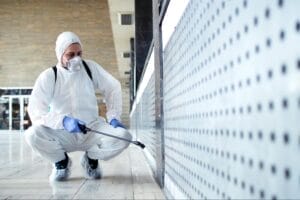Mold can start growing within 24 to 48 hours after water damage occurs. Rapid response to water leaks and moisture issues is crucial to prevent mold growth and the need for extensive remediation.
Factors Affecting The Growth Of Mold After Water Damage
Several factors contribute to the growth of mold following water damage:
- Presence of Moisture: Excess moisture promotes mold growth. Addressing leaks and drying wet areas promptly is essential. Waterlogged materials such as carpets and drywall are particularly susceptible.
- Temperature: Warmer temperatures accelerate mold growth compared to cooler environments. Mold thrives in temperatures between 77°F and 86°F (25°C and 30°C), making humid climates more prone to mold issues.
- Humidity Levels: High humidity creates favorable conditions for mold. Indoor humidity levels above 60% can facilitate mold growth, especially in poorly ventilated areas like basements and attics.
- Organic Materials: Materials like wood, drywall, and cellulose-based insulation provide nutrients for mold, facilitating faster growth. Porous materials absorb moisture and can sustain mold growth even after drying.
- Time: The longer materials remain wet, the greater the likelihood of mold growth. Mold can continue to develop on damp surfaces if not properly dried within 24 to 48 hours.

Should I Remove the Mold Myself or Call a Professional?
When dealing with mold, it’s important to prioritize safety and effectiveness. DIY methods for mold removal may not fully eliminate the mold or prevent its return. Calling a professional mold remediation service ensures thorough removal and addresses underlying moisture issues, reducing the risk of mold recurrence.
What Happens If I Don’t Remove Mold?
If mold is left untreated, it can spread rapidly and cause extensive damage to building materials and furnishings. Additionally, mold exposure can lead to health problems such as allergies, respiratory issues, and even neurological effects in some individuals. The longer mold is allowed to grow, the more challenging and costly remediation becomes.
When is the Right Time to Remove Mold?
The right time to remove mold is as soon as it’s detected. Prompt action helps prevent further damage and reduces the scope of remediation required. Early intervention also minimizes health risks associated with mold exposure. Mold can quickly spread throughout a property if left unchecked, complicating cleanup efforts.
How Does Mold Grow Indoors?
Mold grows indoors when spores land on damp surfaces and find suitable conditions for growth. These conditions typically include moisture, warmth, and organic materials to feed on. Mold can spread quickly if these factors persist, establishing colonies that release spores into the air.
When to Consult a Mold Remediation Professional
If you suspect mold growth in your home but are unsure of the extent or best course of action, consulting a mold remediation professional is advisable. They can conduct a comprehensive inspection, assess the severity of the mold problem, and recommend appropriate remediation measures tailored to your specific situation. Professional services ensure thorough removal and help prevent future mold issues, safeguarding your home and health.
What is the Difference Between Mold Removal and Mold Remediation?
If you’re curious about the distinction between Mold Removal and Mold Remediation, explore our detailed guide on What is the Difference Between Mold Removal and Mold Remediation? For further insights into preventing mold growth.




